Predictive Business Analytics Report: Analysis, Methods, and Benefits
VerifiedAdded on 2020/05/11
|6
|1314
|328
Report
AI Summary
This report delves into the significance of predictive business analytics, emphasizing its role in providing organizations with a competitive edge. It explores the necessity of predictive analytics in fraud detection, marketing campaigns, and operational enhancements, highlighting the utility of logic-driven models in developing data-driven strategies. The report also discusses the benefits of neural networks in determining associations and classification tasks, the importance of establishing clusters for innovation, and the significance of establishing associations in business analytics. Furthermore, it examines the application of F-tests from ANOVA in statistical analysis, presenting a comprehensive overview of the methods and benefits of predictive analytics in a business context.
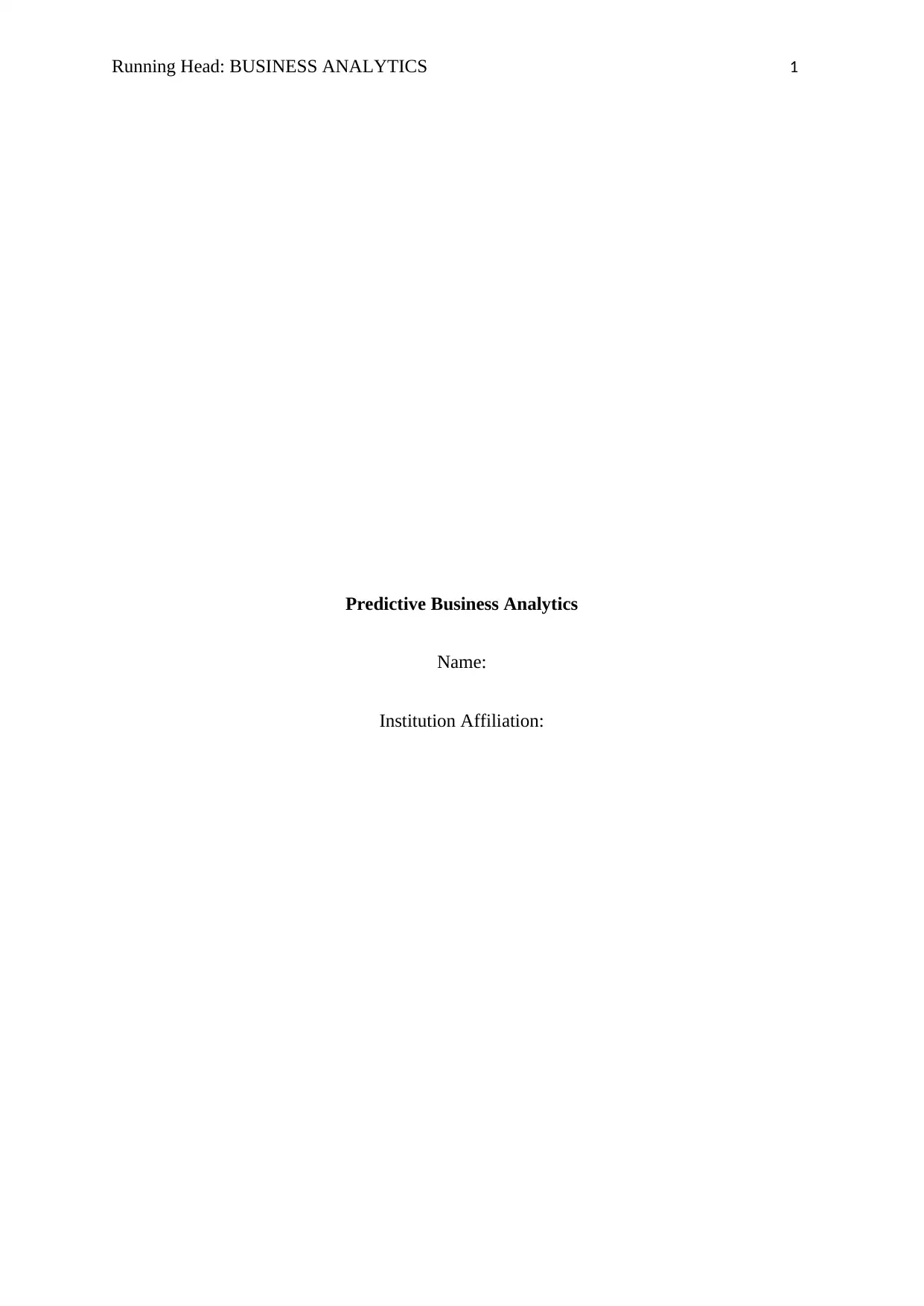
Running Head: BUSINESS ANALYTICS 1
Predictive Business Analytics
Name:
Institution Affiliation:
Predictive Business Analytics
Name:
Institution Affiliation:
Paraphrase This Document
Need a fresh take? Get an instant paraphrase of this document with our AI Paraphraser
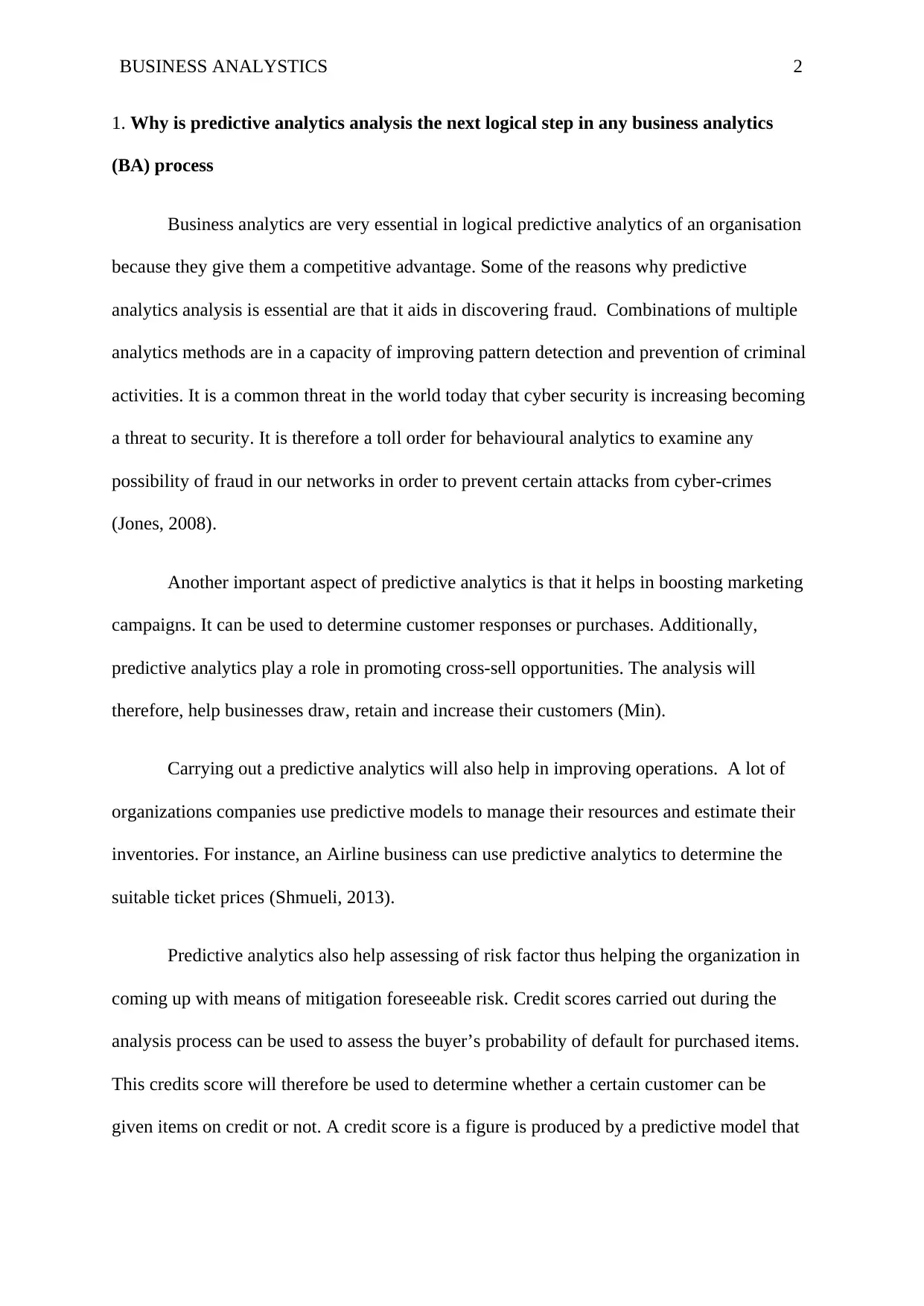
BUSINESS ANALYSTICS 2
1. Why is predictive analytics analysis the next logical step in any business analytics
(BA) process
Business analytics are very essential in logical predictive analytics of an organisation
because they give them a competitive advantage. Some of the reasons why predictive
analytics analysis is essential are that it aids in discovering fraud. Combinations of multiple
analytics methods are in a capacity of improving pattern detection and prevention of criminal
activities. It is a common threat in the world today that cyber security is increasing becoming
a threat to security. It is therefore a toll order for behavioural analytics to examine any
possibility of fraud in our networks in order to prevent certain attacks from cyber-crimes
(Jones, 2008).
Another important aspect of predictive analytics is that it helps in boosting marketing
campaigns. It can be used to determine customer responses or purchases. Additionally,
predictive analytics play a role in promoting cross-sell opportunities. The analysis will
therefore, help businesses draw, retain and increase their customers (Min).
Carrying out a predictive analytics will also help in improving operations. A lot of
organizations companies use predictive models to manage their resources and estimate their
inventories. For instance, an Airline business can use predictive analytics to determine the
suitable ticket prices (Shmueli, 2013).
Predictive analytics also help assessing of risk factor thus helping the organization in
coming up with means of mitigation foreseeable risk. Credit scores carried out during the
analysis process can be used to assess the buyer’s probability of default for purchased items.
This credits score will therefore be used to determine whether a certain customer can be
given items on credit or not. A credit score is a figure is produced by a predictive model that
1. Why is predictive analytics analysis the next logical step in any business analytics
(BA) process
Business analytics are very essential in logical predictive analytics of an organisation
because they give them a competitive advantage. Some of the reasons why predictive
analytics analysis is essential are that it aids in discovering fraud. Combinations of multiple
analytics methods are in a capacity of improving pattern detection and prevention of criminal
activities. It is a common threat in the world today that cyber security is increasing becoming
a threat to security. It is therefore a toll order for behavioural analytics to examine any
possibility of fraud in our networks in order to prevent certain attacks from cyber-crimes
(Jones, 2008).
Another important aspect of predictive analytics is that it helps in boosting marketing
campaigns. It can be used to determine customer responses or purchases. Additionally,
predictive analytics play a role in promoting cross-sell opportunities. The analysis will
therefore, help businesses draw, retain and increase their customers (Min).
Carrying out a predictive analytics will also help in improving operations. A lot of
organizations companies use predictive models to manage their resources and estimate their
inventories. For instance, an Airline business can use predictive analytics to determine the
suitable ticket prices (Shmueli, 2013).
Predictive analytics also help assessing of risk factor thus helping the organization in
coming up with means of mitigation foreseeable risk. Credit scores carried out during the
analysis process can be used to assess the buyer’s probability of default for purchased items.
This credits score will therefore be used to determine whether a certain customer can be
given items on credit or not. A credit score is a figure is produced by a predictive model that
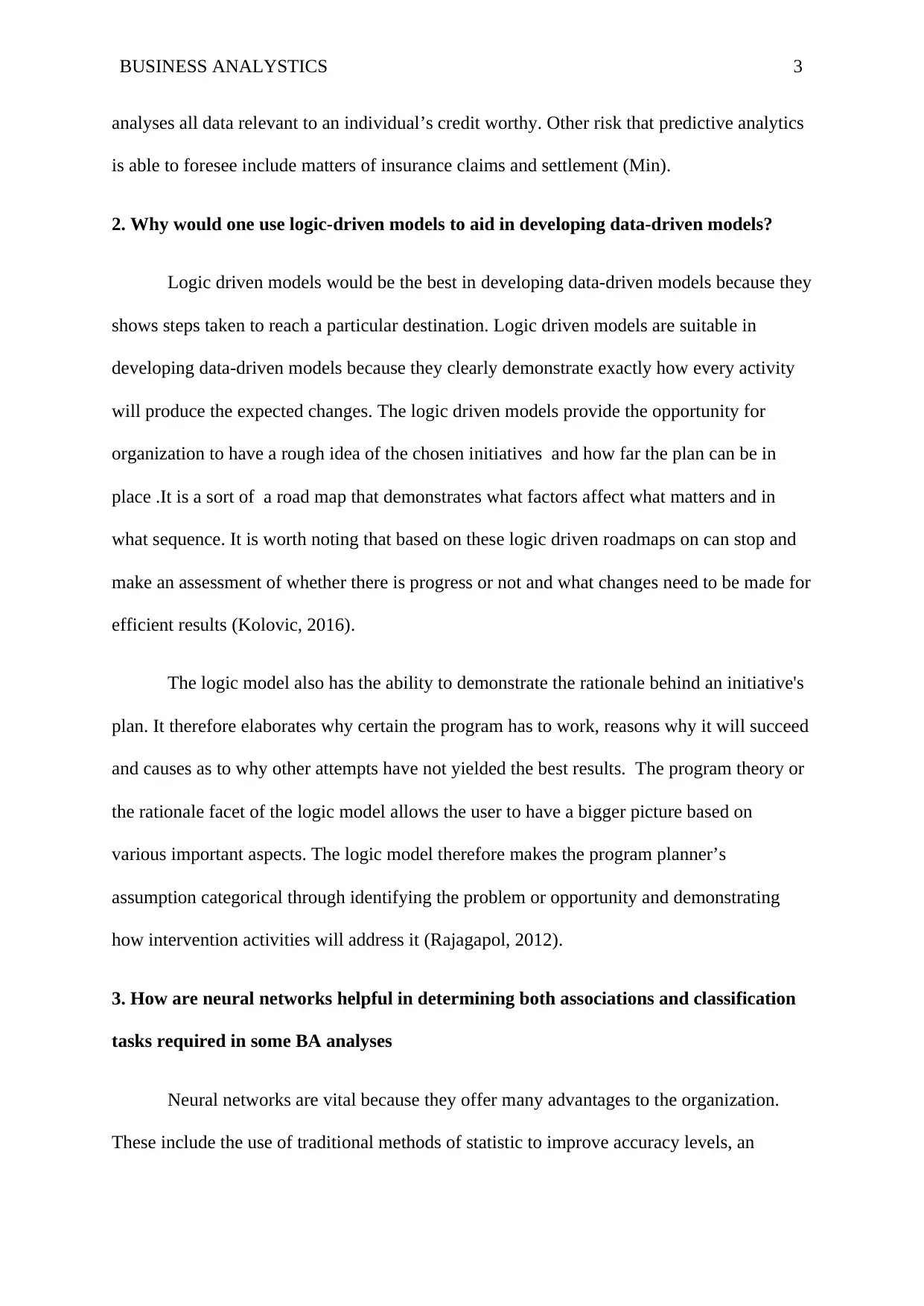
BUSINESS ANALYSTICS 3
analyses all data relevant to an individual’s credit worthy. Other risk that predictive analytics
is able to foresee include matters of insurance claims and settlement (Min).
2. Why would one use logic-driven models to aid in developing data-driven models?
Logic driven models would be the best in developing data-driven models because they
shows steps taken to reach a particular destination. Logic driven models are suitable in
developing data-driven models because they clearly demonstrate exactly how every activity
will produce the expected changes. The logic driven models provide the opportunity for
organization to have a rough idea of the chosen initiatives and how far the plan can be in
place .It is a sort of a road map that demonstrates what factors affect what matters and in
what sequence. It is worth noting that based on these logic driven roadmaps on can stop and
make an assessment of whether there is progress or not and what changes need to be made for
efficient results (Kolovic, 2016).
The logic model also has the ability to demonstrate the rationale behind an initiative's
plan. It therefore elaborates why certain the program has to work, reasons why it will succeed
and causes as to why other attempts have not yielded the best results. The program theory or
the rationale facet of the logic model allows the user to have a bigger picture based on
various important aspects. The logic model therefore makes the program planner’s
assumption categorical through identifying the problem or opportunity and demonstrating
how intervention activities will address it (Rajagapol, 2012).
3. How are neural networks helpful in determining both associations and classification
tasks required in some BA analyses
Neural networks are vital because they offer many advantages to the organization.
These include the use of traditional methods of statistic to improve accuracy levels, an
analyses all data relevant to an individual’s credit worthy. Other risk that predictive analytics
is able to foresee include matters of insurance claims and settlement (Min).
2. Why would one use logic-driven models to aid in developing data-driven models?
Logic driven models would be the best in developing data-driven models because they
shows steps taken to reach a particular destination. Logic driven models are suitable in
developing data-driven models because they clearly demonstrate exactly how every activity
will produce the expected changes. The logic driven models provide the opportunity for
organization to have a rough idea of the chosen initiatives and how far the plan can be in
place .It is a sort of a road map that demonstrates what factors affect what matters and in
what sequence. It is worth noting that based on these logic driven roadmaps on can stop and
make an assessment of whether there is progress or not and what changes need to be made for
efficient results (Kolovic, 2016).
The logic model also has the ability to demonstrate the rationale behind an initiative's
plan. It therefore elaborates why certain the program has to work, reasons why it will succeed
and causes as to why other attempts have not yielded the best results. The program theory or
the rationale facet of the logic model allows the user to have a bigger picture based on
various important aspects. The logic model therefore makes the program planner’s
assumption categorical through identifying the problem or opportunity and demonstrating
how intervention activities will address it (Rajagapol, 2012).
3. How are neural networks helpful in determining both associations and classification
tasks required in some BA analyses
Neural networks are vital because they offer many advantages to the organization.
These include the use of traditional methods of statistic to improve accuracy levels, an
⊘ This is a preview!⊘
Do you want full access?
Subscribe today to unlock all pages.

Trusted by 1+ million students worldwide
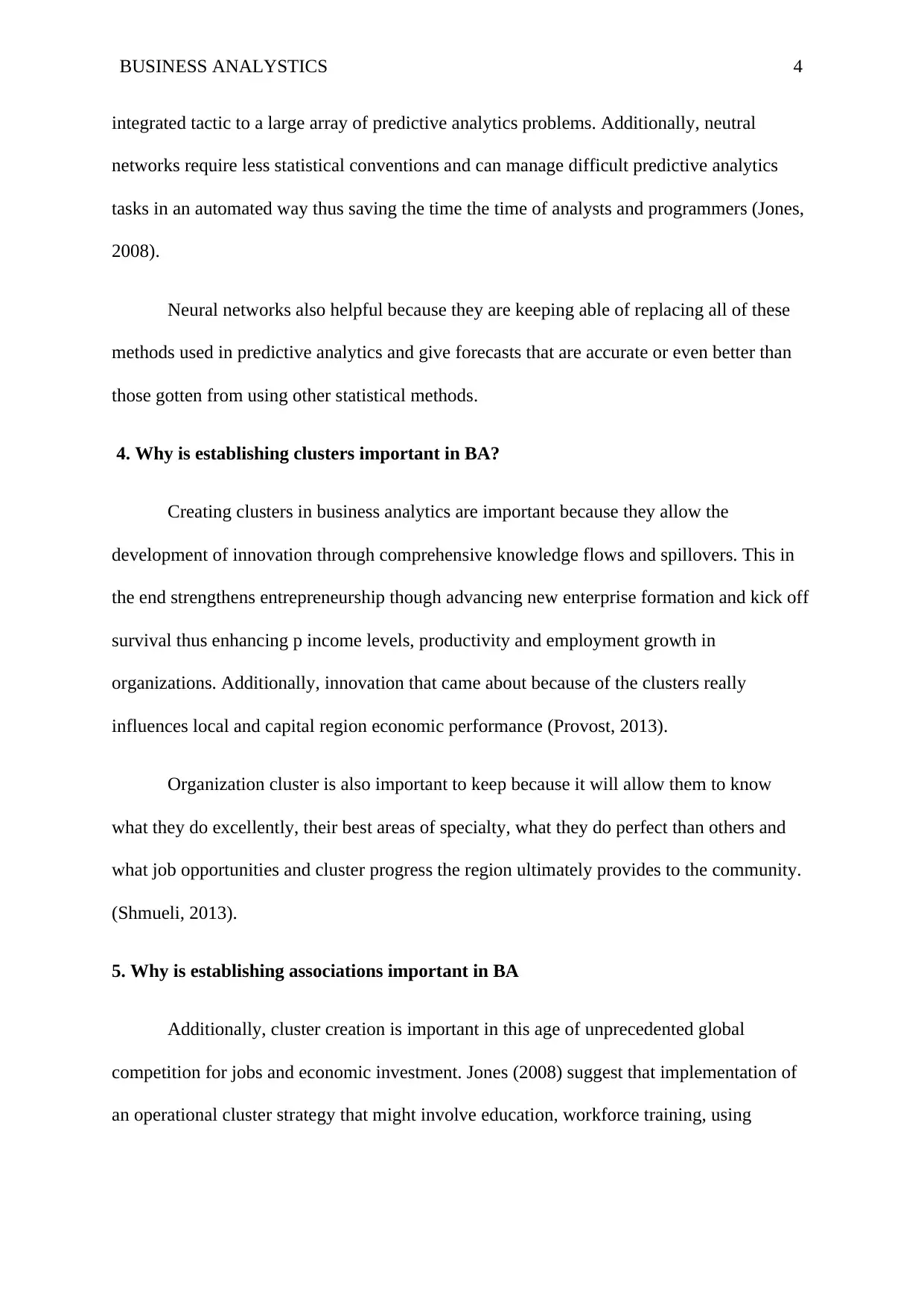
BUSINESS ANALYSTICS 4
integrated tactic to a large array of predictive analytics problems. Additionally, neutral
networks require less statistical conventions and can manage difficult predictive analytics
tasks in an automated way thus saving the time the time of analysts and programmers (Jones,
2008).
Neural networks also helpful because they are keeping able of replacing all of these
methods used in predictive analytics and give forecasts that are accurate or even better than
those gotten from using other statistical methods.
4. Why is establishing clusters important in BA?
Creating clusters in business analytics are important because they allow the
development of innovation through comprehensive knowledge flows and spillovers. This in
the end strengthens entrepreneurship though advancing new enterprise formation and kick off
survival thus enhancing p income levels, productivity and employment growth in
organizations. Additionally, innovation that came about because of the clusters really
influences local and capital region economic performance (Provost, 2013).
Organization cluster is also important to keep because it will allow them to know
what they do excellently, their best areas of specialty, what they do perfect than others and
what job opportunities and cluster progress the region ultimately provides to the community.
(Shmueli, 2013).
5. Why is establishing associations important in BA
Additionally, cluster creation is important in this age of unprecedented global
competition for jobs and economic investment. Jones (2008) suggest that implementation of
an operational cluster strategy that might involve education, workforce training, using
integrated tactic to a large array of predictive analytics problems. Additionally, neutral
networks require less statistical conventions and can manage difficult predictive analytics
tasks in an automated way thus saving the time the time of analysts and programmers (Jones,
2008).
Neural networks also helpful because they are keeping able of replacing all of these
methods used in predictive analytics and give forecasts that are accurate or even better than
those gotten from using other statistical methods.
4. Why is establishing clusters important in BA?
Creating clusters in business analytics are important because they allow the
development of innovation through comprehensive knowledge flows and spillovers. This in
the end strengthens entrepreneurship though advancing new enterprise formation and kick off
survival thus enhancing p income levels, productivity and employment growth in
organizations. Additionally, innovation that came about because of the clusters really
influences local and capital region economic performance (Provost, 2013).
Organization cluster is also important to keep because it will allow them to know
what they do excellently, their best areas of specialty, what they do perfect than others and
what job opportunities and cluster progress the region ultimately provides to the community.
(Shmueli, 2013).
5. Why is establishing associations important in BA
Additionally, cluster creation is important in this age of unprecedented global
competition for jobs and economic investment. Jones (2008) suggest that implementation of
an operational cluster strategy that might involve education, workforce training, using
Paraphrase This Document
Need a fresh take? Get an instant paraphrase of this document with our AI Paraphraser
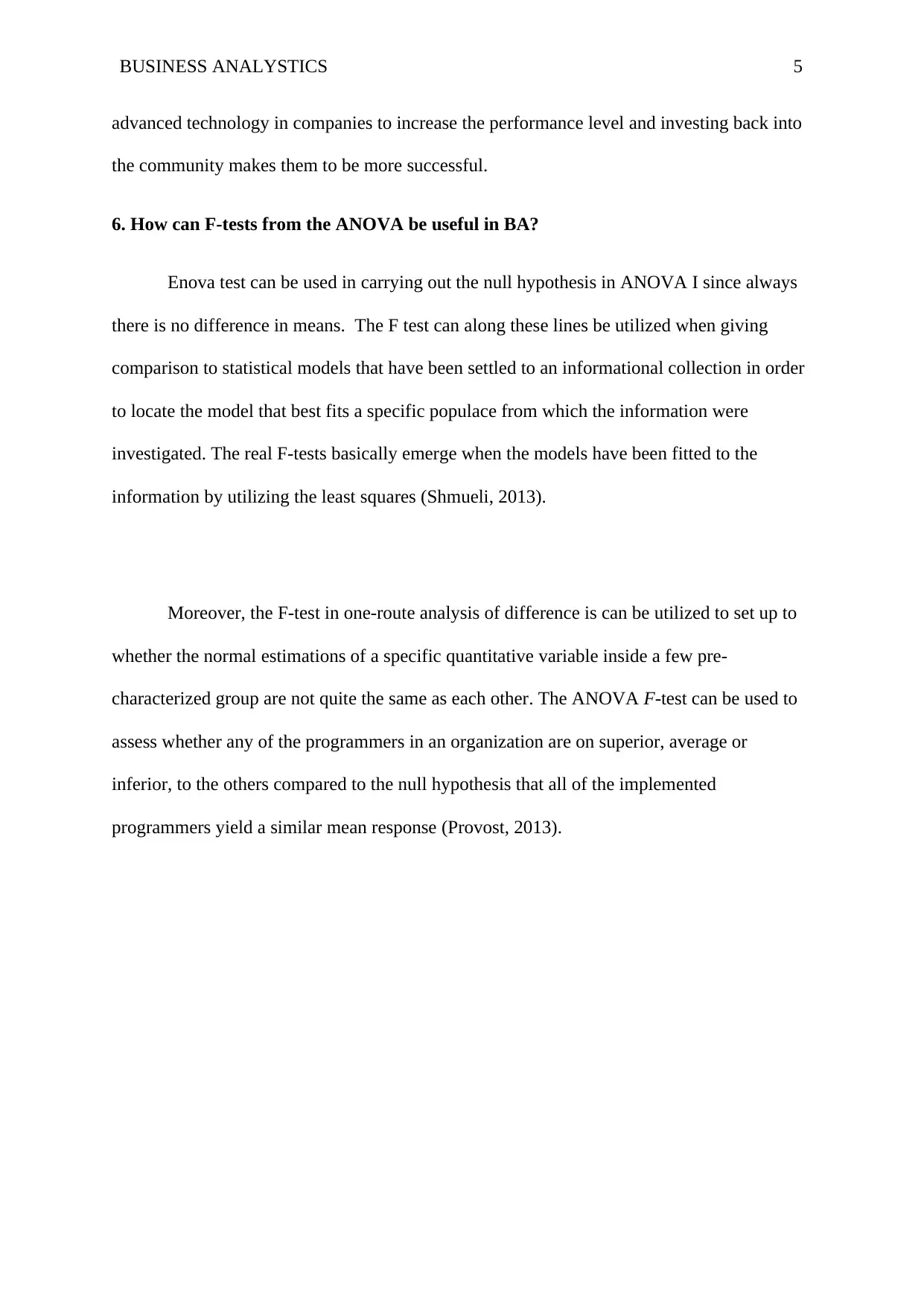
BUSINESS ANALYSTICS 5
advanced technology in companies to increase the performance level and investing back into
the community makes them to be more successful.
6. How can F-tests from the ANOVA be useful in BA?
Enova test can be used in carrying out the null hypothesis in ANOVA I since always
there is no difference in means. The F test can along these lines be utilized when giving
comparison to statistical models that have been settled to an informational collection in order
to locate the model that best fits a specific populace from which the information were
investigated. The real F-tests basically emerge when the models have been fitted to the
information by utilizing the least squares (Shmueli, 2013).
Moreover, the F-test in one-route analysis of difference is can be utilized to set up to
whether the normal estimations of a specific quantitative variable inside a few pre-
characterized group are not quite the same as each other. The ANOVA F-test can be used to
assess whether any of the programmers in an organization are on superior, average or
inferior, to the others compared to the null hypothesis that all of the implemented
programmers yield a similar mean response (Provost, 2013).
advanced technology in companies to increase the performance level and investing back into
the community makes them to be more successful.
6. How can F-tests from the ANOVA be useful in BA?
Enova test can be used in carrying out the null hypothesis in ANOVA I since always
there is no difference in means. The F test can along these lines be utilized when giving
comparison to statistical models that have been settled to an informational collection in order
to locate the model that best fits a specific populace from which the information were
investigated. The real F-tests basically emerge when the models have been fitted to the
information by utilizing the least squares (Shmueli, 2013).
Moreover, the F-test in one-route analysis of difference is can be utilized to set up to
whether the normal estimations of a specific quantitative variable inside a few pre-
characterized group are not quite the same as each other. The ANOVA F-test can be used to
assess whether any of the programmers in an organization are on superior, average or
inferior, to the others compared to the null hypothesis that all of the implemented
programmers yield a similar mean response (Provost, 2013).
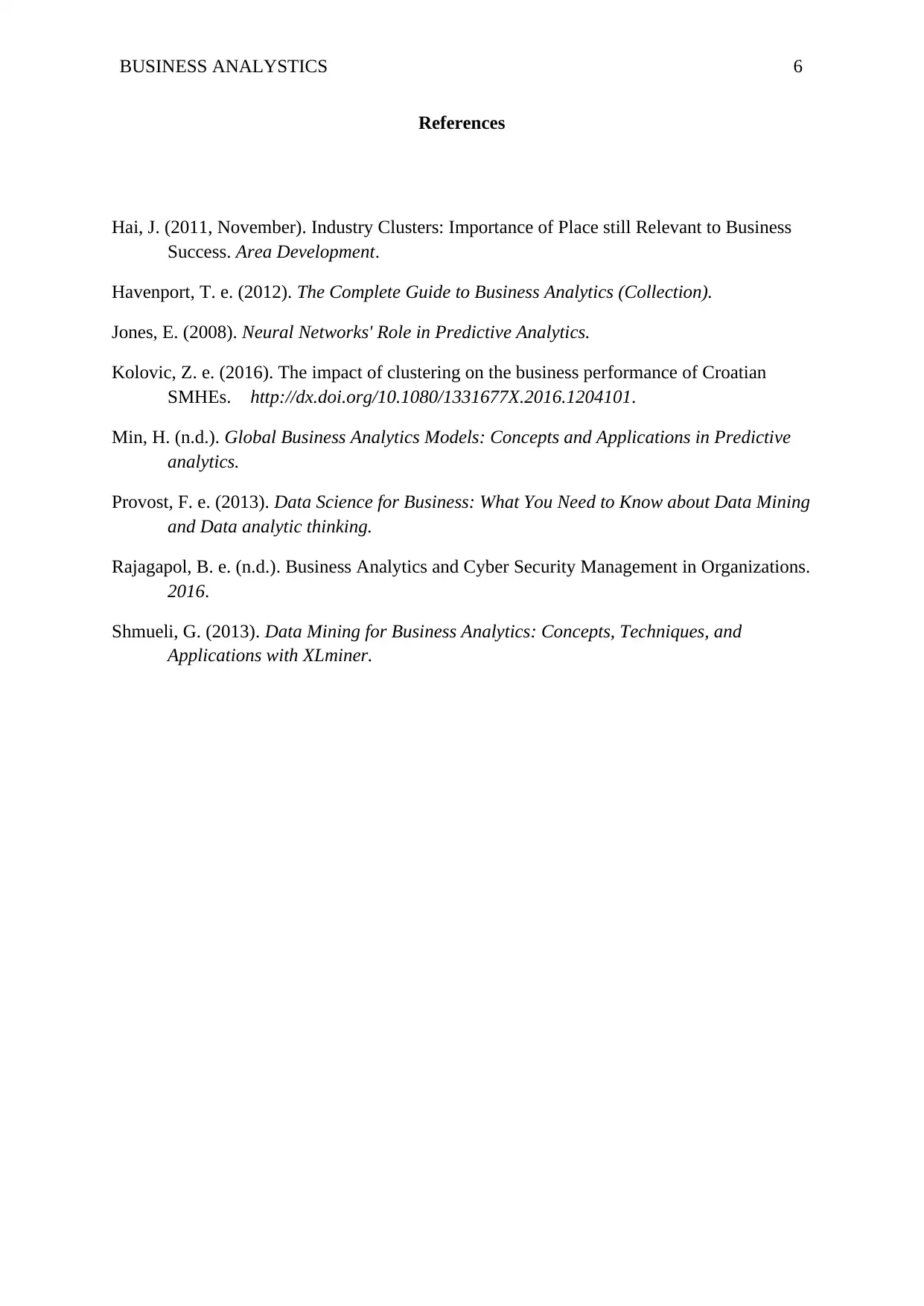
BUSINESS ANALYSTICS 6
References
Hai, J. (2011, November). Industry Clusters: Importance of Place still Relevant to Business
Success. Area Development.
Havenport, T. e. (2012). The Complete Guide to Business Analytics (Collection).
Jones, E. (2008). Neural Networks' Role in Predictive Analytics.
Kolovic, Z. e. (2016). The impact of clustering on the business performance of Croatian
SMHEs. http://dx.doi.org/10.1080/1331677X.2016.1204101.
Min, H. (n.d.). Global Business Analytics Models: Concepts and Applications in Predictive
analytics.
Provost, F. e. (2013). Data Science for Business: What You Need to Know about Data Mining
and Data analytic thinking.
Rajagapol, B. e. (n.d.). Business Analytics and Cyber Security Management in Organizations.
2016.
Shmueli, G. (2013). Data Mining for Business Analytics: Concepts, Techniques, and
Applications with XLminer.
References
Hai, J. (2011, November). Industry Clusters: Importance of Place still Relevant to Business
Success. Area Development.
Havenport, T. e. (2012). The Complete Guide to Business Analytics (Collection).
Jones, E. (2008). Neural Networks' Role in Predictive Analytics.
Kolovic, Z. e. (2016). The impact of clustering on the business performance of Croatian
SMHEs. http://dx.doi.org/10.1080/1331677X.2016.1204101.
Min, H. (n.d.). Global Business Analytics Models: Concepts and Applications in Predictive
analytics.
Provost, F. e. (2013). Data Science for Business: What You Need to Know about Data Mining
and Data analytic thinking.
Rajagapol, B. e. (n.d.). Business Analytics and Cyber Security Management in Organizations.
2016.
Shmueli, G. (2013). Data Mining for Business Analytics: Concepts, Techniques, and
Applications with XLminer.
⊘ This is a preview!⊘
Do you want full access?
Subscribe today to unlock all pages.

Trusted by 1+ million students worldwide
1 out of 6
Related Documents
Your All-in-One AI-Powered Toolkit for Academic Success.
+13062052269
info@desklib.com
Available 24*7 on WhatsApp / Email
![[object Object]](/_next/static/media/star-bottom.7253800d.svg)
Unlock your academic potential
Copyright © 2020–2025 A2Z Services. All Rights Reserved. Developed and managed by ZUCOL.





